Pistol Action Plays
By Dr. James Gels, From the Coach’s Clipboard Basketball Playbook"Helping coaches coach better..."
There are a lot of new terms being used to describe basketball actions that have actually been around for awhile. "Pistol" action refers to an early offense action between the point guard and a wing player, with a post player at the top of the arc. It is also referred to as "21" because of the interaction between O2 and O1. Pistol has been used at all levels of the game - pro, college, high school.
Pistol usually starts with one of two options - a dribble or a pass. In both cases, O1 brings the ball up along one sideline (not in the middle), and starts the action from there.
The point guard may dribble at a wing player and use the wing player's screen, or make a dribble hand-off to the wing. Or the point guard may pass to the wing, and follow the pass to the wing (with several options thereafter - ball-screen, return dribble hand-off, clear-out, etc). The post player usually sets flare-screens or ball-screens for O1 or O2. Of course you can run this on the left side as well with O1 and O3.
Many coaches have their own way of running pistol, with many options. For example, some coaches may interchange either O4 or O3 as the screener at the top (instead of O5), which sometimes results in a mismatch for the defense. Pistol is a good way to get into your offense. This article describes just a few actions.
Dribble-Entry
In diagram 1, O1 dribbles toward O2, who screens for O1. O2 then receives a flare-screen from O5. On the weakside O4 screens for O3. In this diagram, O1 dribbles around the screen and attacks the hoop for a layup. O1 could pass inside to O4 slipping to the rim after the O4/O3 screen. Other options for O1 are a pull up jump-shot or a 3-point shot after coming around the screen.
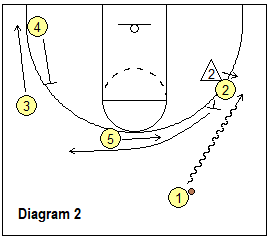
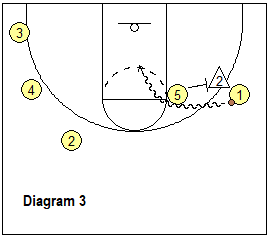
If the X2 defender switches and jumps out to stop O1's dribble penetration (diagram 2), O1 can skip-pass to O2 who is open after coming off O5's flare-screen - for a 3-point shot. If the pass to O2 is not open, O5 ball-screens for O1 (who has kept his/her dribble alive) for a pick and roll action (diagram 3).
Diagram 4 again shows O1 dribbling to the wing. This time, his/her defender (X1) goes under O2's ball-screen. O1 steps back and shoots the 3-point shot (diagram 5).
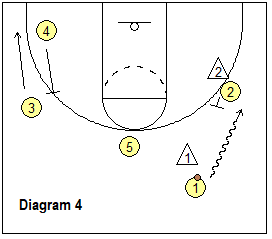
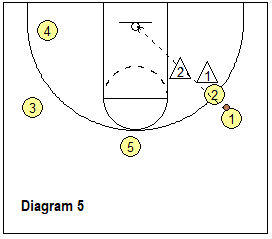
Wing Pass-Entry
Diagram 6 shows O1 starting the action with a pass to the wing. O1 follows the pass around O2. Here, O1 clears to the corner, but other options include ball-screening for O2, or receiving a dribble hand-off from O2. O4 again screens for O3 on the weakside. O5 then ball-screens for O2 for a pick and roll action (diagram 7).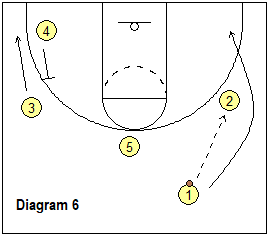
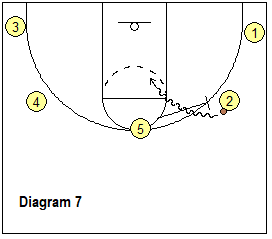
Diagram 8 again shows a pass from O1 to the wing. This time O1 receives a dribble hand-off from O2 (diagram 9), as O5 flare-screens for O2. After receiving the hand-off, O1 has the options of a dribble-drive to the hoop or a jump-shot.
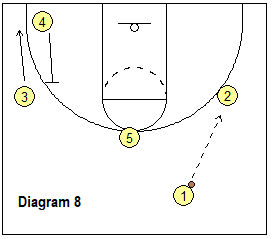
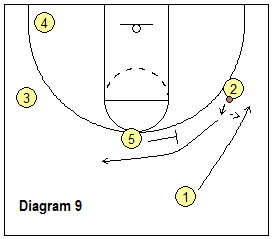
Diagram 10 shows another option - O1 skip-passes to O2 coming over O5's flare-screen for a 3-pointer. If that's not open, O5 then ball-screens for O1 (diagram 11) for a pick and roll action.
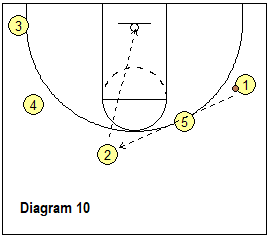
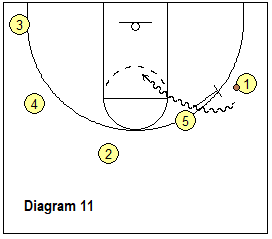
With any of these actions, dribble-penetration can result in an inside-out pass to the opposite arc for an open 3-point shot. In addition, screeners may slip screens and cut inside for a quick pass. O5 might slip inside after flare-screening for O2. Another example is O2, after dribble handing-off to O1, could slip inside for a quick pass from O1 (instead of using the top O5 flare-screen).
There are many options and an Internet search will provide many other ideas. See the video below for some examples.